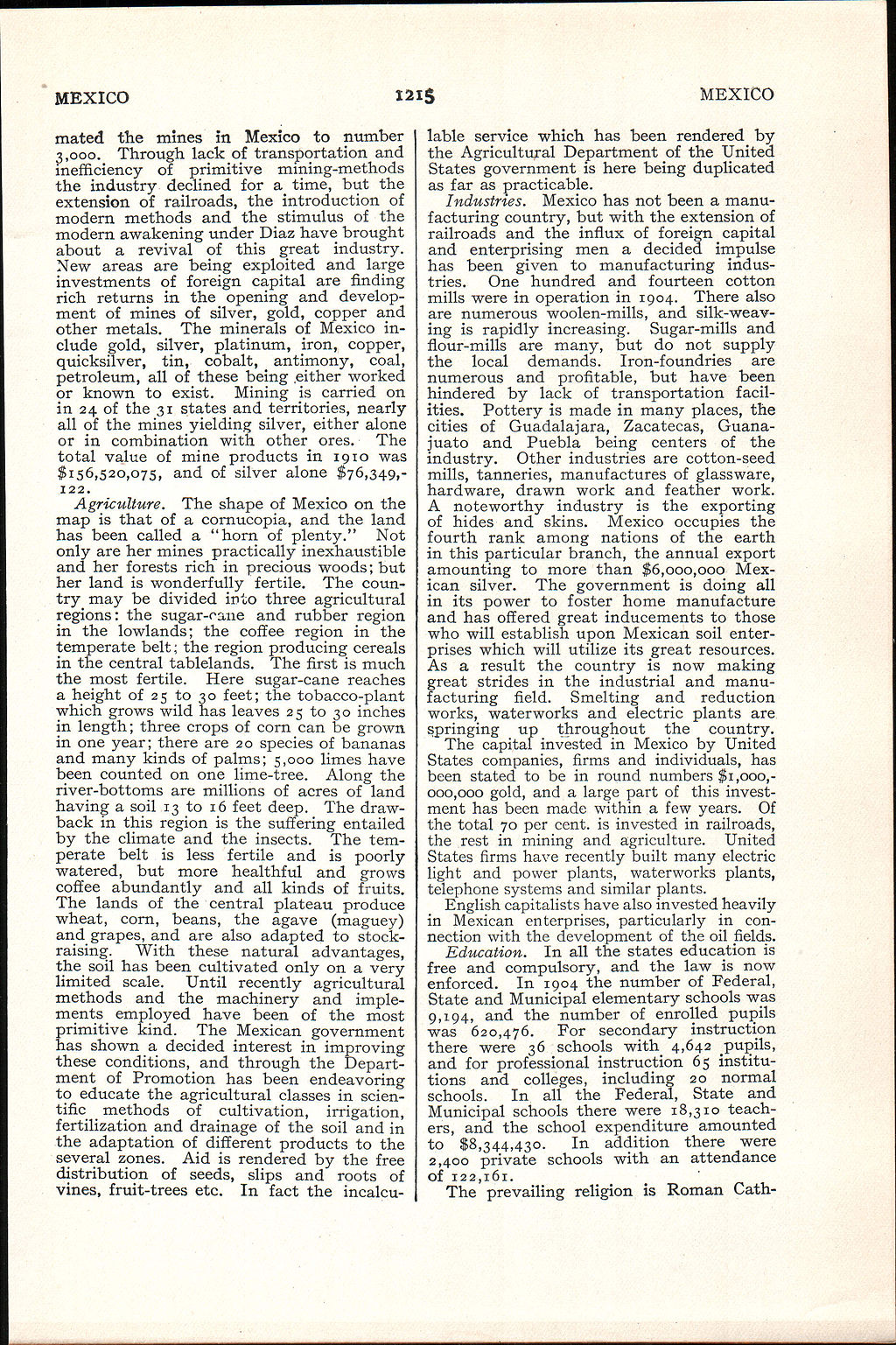mated the mines in Mexico to number
3,000. Through lack of transportation and
inefficiency of primitive mining-methods
the industry declined for a time, but the
extension of railroads, the introduction of
modern methods and the stimulus of the
modern awakening under Diaz have brought
about a revival of this great industry.
New areas are being exploited and large
investments of foreign capital are finding
rich returns in the opening and development
of mines of silver, gold, copper and
other metals. The minerals of Mexico
include gold, silver, platinum, iron, copper,
quicksilver, tin, cobalt, antimony, coal,
petroleum, all of these being either worked
or known to exist. Mining is carried on
in 24 of the 31 states and territories, nearly
all of the mines yielding silver, either alone
or in combination with other ores. The
total value of mine products in 1910 was
$156,520,075, and of silver alone
$76,349,122.
Agriculture. The shape of Mexico on the map is that of a cornucopia, and the land has been called a “horn of plenty.” Not only are her mines practically inexhaustible and her forests rich in precious woods; but her land is wonderfully fertile. The country may be divided into three agricultural regions: the sugar-cane and rubber region in the lowlands; the coffee region in the temperate belt; the region producing cereals in the central tablelands. The first is much the most fertile. Here sugar-cane reaches a height of 25 to 30 feet; the tobacco-plant which grows wild has leaves 25 to 30 inches in length; three crops of corn can be grown in one year; there are 20 species of bananas and many kinds of palms; 5,000 limes have been counted on one lime-tree. Along the river-bottoms are millions of acres of land having a soil 13 to 16 feet deep. The drawback in this region is the suffering entailed by the climate and the insects. The temperate belt is less fertile and is poorly watered, but more healthful and grows coffee abundantly and all kinds of fruits. The lands of the central plateau produce wheat, corn, beans, the agave (maguey) and grapes, and are also adapted to stock-raising. With these natural advantages, the soil has been cultivated only on a very limited scale. Until recently agricultural methods and the machinery and implements employed have been of the most primitive kind. The Mexican government has shown a decided interest in improving these conditions, and through the Department of Promotion has been endeavoring to educate the agricultural classes in scientific methods of cultivation, irrigation, fertilization and drainage of the soil and in the adaptation of different products to the several zones. Aid is rendered by the free distribution of seeds, slips and roots of vines, fruit-trees etc. In fact the incalculable service which has been rendered by the Agricultural Department of the United States government is here being duplicated as far as practicable.
Industries. Mexico has not been a manufacturing country, but with the extension of railroads and the influx of foreign capital and enterprising men a decided impulse has been given to manufacturing industries. One hundred and fourteen cotton mills were in operation in 1904. There also are numerous woolen-mills, and silk-weaving is rapidly increasing. Sugar-mills and flour-mills are many, but do not supply the local demands. Iron-foundries are numerous and profitable, but have been hindered by lack of transportation facilities. Pottery is made in many places, the cities of Guadalajara, Zacatecas, Guanajuato and Puebla being centers of the industry. Other industries are cotton-seed mills, tanneries, manufactures of glassware, hardware, drawn work and feather work. A noteworthy industry is the exporting of hides and skins. Mexico occupies the fourth rank among nations of the earth in this particular branch, the annual export amounting to more than $6,000,000 Mexican silver. The government is doing all in its power to foster home manufacture and has offered great inducements to those who will establish upon Mexican soil enterprises which will utilize its great resources. As a result the country is now making great strides in the industrial and manufacturing field. Smelting and reduction works, waterworks and electric plants are springing up throughout the country.
The capital invested in Mexico by United States companies, firms and individuals, has been stated to be in round numbers $1,000,000,000 gold, and a large part of this investment has been made within a few years. Of the total 70 per cent. is invested in railroads, the rest in mining and agriculture. United States firms have recently built many electric light and power plants, waterworks plants, telephone systems and similar plants.
English capitalists have also invested heavily in Mexican enterprises, particularly in connection with the development of the oil fields.
Education. In all the states education is free and compulsory, and the law is now enforced. In 1904 the number of Federal, State and Municipal elementary schools was 9,194, and the number of enrolled pupils was 620,476. For secondary instruction there were 36 schools with 4,642 pupils, and for professional instruction 65 institutions and colleges, including 20 normal schools. In all the Federal, State and Municipal schools there were 18,310 teachers, and the school expenditure amounted to $8,344,430. In addition there were 2,400 private schools with an attendance of 122,161.
The prevailing religion is Roman Cath-
